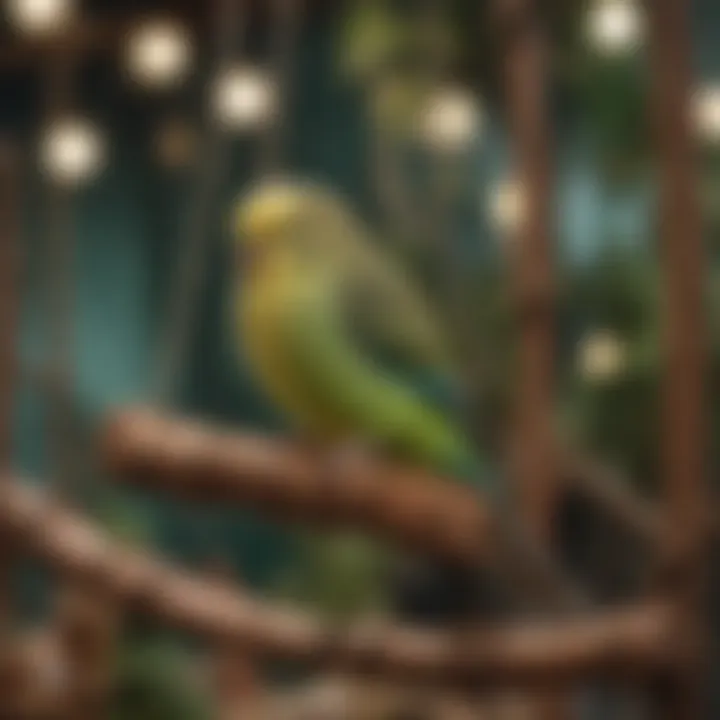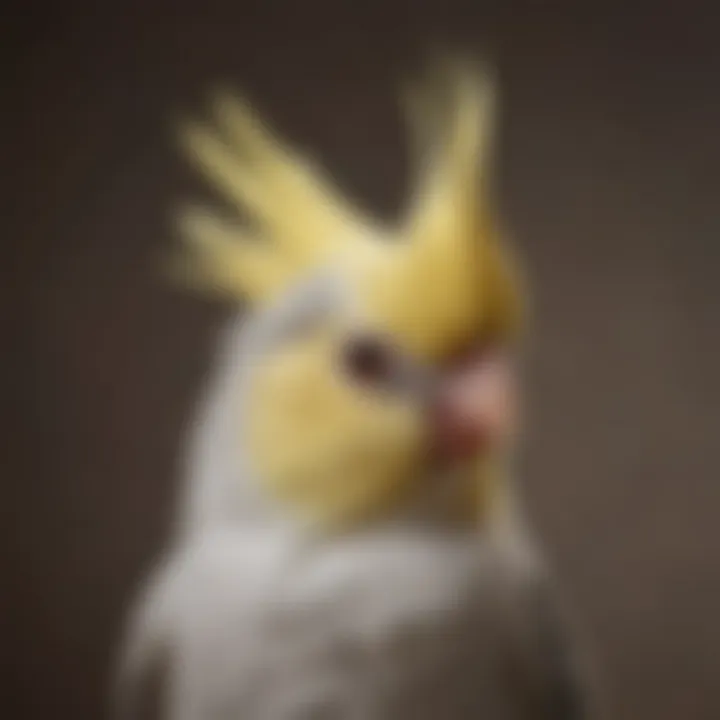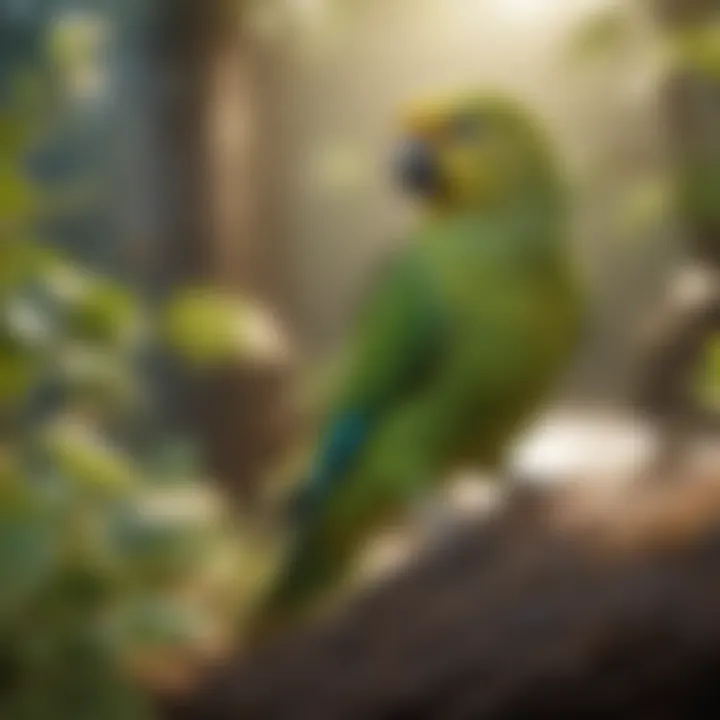Easy Birds to Care For: A Guide for Enthusiasts


Intro
Birds possess a unique charm that captivates enthusiasts and casual observers alike. For those who seek companionship through avian friends, choosing the right species can make all the difference. Understanding which birds are low-maintenance is essential for individuals who want to enjoy pet ownership without excessive effort.
This guide looks at various bird types suitable for low-maintenance environments. It highlights not only specific care requirements but also behavioral patterns, social needs, and dietary necessities. By delving into these aspects, readers can make better-informed decisions that safeguard the well-being of their feathered companions.
Equipped with the right know-how, both seasoned and inexperienced bird owners can steer towards enhancing their experiences with these delightful pets. Let's explore the foundational care tips that can help deliver an enriching environment for easy-care birds.
Care Tips
Having the right care routines is crucial in keeping pet birds happy and healthy. Daily attention and environment management ensure that these companions thrive in domestic settings. This section covers essential practices that readers should embrace for effective bird care.
Daily Care Routines
Consistent attention is key for any pet. For birds, daily routines might include:
- Feeding: Provide fresh food each day, ensuring a varied diet.
- Social Interaction: Birds are social creatures and benefit from daily engagement with their owners.
- Time Outside the Cage: Allowing birds to fly outside their cage safely helps keep them physically fit.
Cage Setup and Maintenance
An appropriate cage is paramount to your bird’s daily life. Key considerations include:
- Size: Choose a cage that offers sufficient space for your bird to stretch its wings. The larger, the better.
- Bar Spacing: Ensure the spacing is appropriate for the bird’s size to prevent escapes or injuries.
A clean environment reduces health risks. Ensure cagemates include safe toys and climbing spaces as part of the environment. Perform weekly cleaning to eliminate waste and residues that accumulate over time.
Hygiene and Cleaning Practices
The hygiene of a bird’s environment is critical. Here are basic cleaning practices:
- Daily Spot Cleaning: Remove droppings from the cage floor immediately.
- Weekly Deep Cleaning: Empty out all items, wash the cage with a mild soapy solution, and rinse thoroughly.
- Wash Toys: Regularly sanitize toys to minimize bacterial growth.
Seasonal Care Adjustments
Changes in seasons necessitate adjustments to care routines. During hotter months, ensure:
- Hydration: Provide fresh water multiple times a day.
- Avoid Sunlight: Position the cage away from direct sunlight during peak hours.
In winter, consider:
- Ample Heat: Keep birds in a warm environment to prevent stress.
- Moisture Control: Use a humidifier if necessary, as dry air can cause issues for birds.
Through proper care routines, bird owners can cultivate a conducive living environment that allows their avian companions to flourish.
Preamble to Easy Care Birds
Birds can be delightful companions. When someone considers bringing a bird into their home, they often seek birds that require lower maintenance. This guide focuses on easy-care birds, helping potential owners understand why these species might be appealing.
Importance of Easy Care Birds
Easy-care birds combine affordability, manageability, and suitable temperaments. They tend to be resilient, making them perfect for beginners and busy individuals. By understanding the specific characteristics of these birds, an owner can provide a comfortable and stimulating environment. Furthermore, the right choice enhances the human-animal bond and reduces stress for both sides.
- Care Requirements: Evaluating care needs ensures owners commit to being responsible.
- Behavioral Traits: Learning about common behaviors helps in understanding avian personalities.
- Living Conditions: Creating an appropriate environment fosters healthy development for the pet.
This guide simplifies the journey towards bird ownership by detailing aspects of care, addressing misconceptions, and equipping readers with invaluable insights. Consequently, readers are able to feel more confident in their decisions and broaden their knowledge.
The journey of any bird owner begins with understanding their species needs.
Ultimately, embracing birds as pets can enrich lives immensely. Proper insight into how to care for simpler species aids in navigating the initial complexities, creating stronger relationships with our avian friends.
The Appeal of Low-Maintenance Birds
Low-maintenance birds attract many potential pet owners due to their relatively simple care needs and rewarding companionship. These birds involve significantly lower daily requirements compared to other pets such as dogs or cats. Consequently, they appeal to people who have limited time for daily interaction and upkeep yet wish to enjoy the company of a pet.
When deciding on a pet, individuals must consider their lifestyles. Not everyone has the flexibility to dedicate hours per day for explicit care and training. Entering the world of easy-care birds allows people to experience companionship with less strain. These species often require less grooming, training, and complex feeding routines, making them more attractive to busy owners.
Additionally, low-maintenance birds can provide visual appeal and showcase remarkable behaviors many find delightful. Factors including vibrant plumage and melodic sounds contribute to their charm. Owners report feeling enriched by interactions, despite being more hands-off. This might explain why families, especially those with children, find low-maintenance pet birds sensible.
Cost is another alluring aspect. Owning low-care birds generally involves lower overall expenses than traditional pets. Common options such as budgies, cockatiels, or finches often require budget-friendly supplies. Therefore, this makes them a practical decision in a challenging economic climate.
Consideration should be towards the bond formed. Some owners find fulfillment even with species requiring limited human interaction. These birds can forge connections built on understanding and affection over time but without requiring strenuous commitment. Owners enjoy peace of mind knowing they have fulfilled basic needs whilst reaping companionship benefits.
“Choosing a low-maintenance bird is practical, enabling pet ownership to fit seamlessly into busy lives.”
As people universally weigh practicality and emotional connection, the allure of easy-care birds strengthens. Understanding these elements proves invaluable if considering first-time bird ownership or looking to streamline an existing pet experience.


Factors to Consider When Choosing a Bird
Choosing a bird as a pet goes beyond simple admiration; it's a committment that involves understanding the unique needs and behavior of these avian companions. Each species brings its own set of requirements, making it essential for prospective owners to evaluate several factors before making a purchase or adoption. Knowing what to consider means less likelihood of future issues in raising the bird within the household. Hence, attention should be given to elements such as space, time, and budget, among others.
Space and Environment Requirements
Proper housing is fundamental in bird care. Different species demand varying amounts of space, and understanding these needs is crucial. For instance, larger birds like African Grey parrots require sizeable cages along with adequate room to exercise. This is important because the right environment plays an important role in their health and well-being.
When preparing a living space, it's wise to check the following:
- Cage size: Larger birds require larger cages.
- Additional space: Birds should also have room to fly within the house, if possible.
- Environmental factors: Place the cage away from drafts and direct sunlight.
Providing enrichment items like perches and toys helps mimic a natural habitat, making it beneficial for species like Budgerigars who thrive in active surroundings.
Time Commitment for Care
A vital point to consider is the amount of time you can realistically dedicate to your bird. Unlike simpler pets such as fish, birds need social interaction and mental stimulation to thrive.
In detail, the care schedule might include:
- Daily cleaning: Regularly clean cages and replace food and water.
- Interaction: Daily engagement through talking or playtime is important, especially for more social species like Cockatiels.
- Health monitoring: Observations for signs of illness or stress require time and attention.
Bird enthusiasts often say that what you put into these interactions will influence the relationship with your pet. Committing to regular quality time is crucial because it potentialy leads to a happier and better-adjusted bird.
Budget Considerations
Budget implications can vary greatly with pet birds, depending largely on the species chosen, the initial purchase price, and ongoing care costs. Be mindful of these factors:
- Purchase costs: Price varies dramatically by species. Exotic birds are generally more expensive to acquire.
- Daily expenses: These include bird feed, toys, and various supplies necessary for their care.
- Healthcare costs: Routine vet visits and emergencies should also be accounted for, as well as vaccinations.
Asking prior bird owners can provide significant insights on these financial aspects. Having a solid plan helps ensure a stable and supportive environment for your feathered friend.
As highlighted, selecting the right bird requires comprehensive consideration of various practical elements. From how much time you will spend, to understanding housing aspects, to planning a suitable budget – all serve as a framework to ensure a harmonious experience in bird ownership.
Top Four Easy Birds to Take Care For
Choosing a pet bird involves understanding which species suit a lifestyle emphasizing convenience and manageability. This section narrows down to the top four easy-care birds. Each bird's maintenance routine, friendliness, and social interactions are evaluated. The goal is to match the right bird with enthusiastic owners looking for minimalistic commitments. Selecting an easy bird grants newcomers access to the joy of bird-keeping while ensuring their avian companions thrive.
Budgerigar (Budgie)
Basic Care Requirements
Budgerigars are highly popular if you are looking into easy-care birds. They require a rather simple diet, primarily consisting of commercial seed mixes supplemented by fresh fruits and veggies. Their habitats can be basic yet effective with appropriately sized cages containing adequate space for movement. Regular cleaning is paramount to maintain a healthy environment. Keeping several birds can promote happiness, but adequate cage space is crucial to offer them comfort.
Social Needs and Interaction
Budgies possess notable social needs. They are known for their friendly disposition, making them a treat for families. Owners should be prepared to engage daily through conversations or play. Grammar loss in quality interactions may result in mild anxiety, leading to adopted birds showing less enthusiasm over time. Therefore, a focus on regular companionship influences their well-being positively.
Common Behavioral Traits
Common behavioral attributes of budgies make them delightful companions. Intelligence shines through learning behaviors; they often mimic speech or attempt to solve puzzles. They also display playful traits. These idiosyncrasies enhance the bond between owner and bird, creating unique interactions—that are hard to forget. However, loud vocalizations may pose concerns for some owners, primarily reserved for when they seek attention.
Cockatiel
Care and Nutrition
Like budgies, cockatiels enjoy a gentle diet containing seeds, pellets, and greens. Adequate nutritional balance contributes significantly to their vitality. They are discerning eaters; hence exploring various nutritional combinations may be beneficial. Neglecting dietary variety can lead to health-related issues, so owners must ensure fine-tuned specification of combinations for maximal health benefit.
Vocalizations and Socialization
Cockatiels thrive on social interaction and enjoy human presence for activity and conversation. They produce enjoyable whistling sounds that are quite charming for attentive owners. Ignoring these verbal calls might create dissatisfaction or boredom. Encouraging positive vocalization through interaction enhances their satisfaction greatly, making good emotional bonds important.
Health Considerations
Though resilient birds, cockatiels can develop specific health conditions if not properly maintained. Owners should familiarize themselves with signs of distress, including changes in appetite or behavior, to seek preventive measures. Regular cage cleaning and ensuring a healthy environment can suspend various possible issues. Understanding health needs should be continuous to avoid oversight and guarantee longer life.
Canary
Cage Setup and Maintenance
Canaries prefer spacious cages allowing for easy flight. Proper ventilation plays a role since insufficient airflow could breed illness. Regular cleaning removes accumulated waste. Ensure the cage contains strategic perches and includes some natural elements contributing to their well-being. Attention to setup ultimately nurtures health and functions of canaries—vital for longevity.
Singing Preferences
Many choose canaries for their beautiful songs. Unique singing types offer melodious enjoyment to owners. Each breed has different singing styles, making the choice extendable based on personal preference. However, may require managing volume, depending on surrounding settings. Singing enhances overall experience, filling homes with joyful soundsthat many appreciate, but controlling soundpieces should be a considered factor.


Nutritional Needs
An adaptable diet is important for active canaries. Proprietary mixes of seeds also ask for supplementation with greens for maintained wellness. Variation prevents monotony in diet which could lead to unwanted health issues. Care givers responsible for nourishment must look into personal preferences, ensuring a balanced system for favrouable outcomes in daily health needs.
Finch
Community Living Arrangements
Finches flourish when housed communally and gravitate towards societies when provided adequate space. Keeping multiple finches relatively generates joy while facilitating observations of various behaviors within groups. Inadequate spaces might breed grevity issues leading to decline in interactions observed throughout different species of birds under assessment. The arrangement fosters social cohesion positively—which becomes crucial to joyful living.
Diverse Diet Options
Offering various seeds, fruits, and greens provide satisfactory nutrition contributing significantly to generation of energy. Customized diet plans maximizing dietary type prevent less cheerful responses as it fuels playfulness within them. However, a need for accessibility solidifies the health guarantee. While food options remain plentiful, appropriate execution becomes central contributing to better satisfaction level
Minimal Social Interaction
Finches exhibit lower degrees of interaction preferences. Well-designed community cages can efficiently cater to multiple finches without overwhelming them under noises or proposed engagement. Although social, they do not demand daily closeness as budgies or cockatiels do, allowing owners more flexible time frames for engagement. Balancing solitude with presence allows these birds to thrive while simultaneously presenting engaging atmospheres outlayed efficiently.
Essential Supplies for Easy Birds
Choosing the right supplies is integral to maintaining a healthy and harmonious environment for easy-care birds. These necessities facilitate daily routines and contribute significantly to the birds’ overall well-being. Understanding what supplies are essential helps new owners feel more confident and prepared. Additionally, the right supplies enhance the avian experience, making bird ownership more enjoyable and less stressful.
Cages and Accessories
The cage serves as a bird's home. A suitable cage must provide sufficient space for the bird to move around freely. When selecting a cage, consider the width, height, and bar spacing. Wide cages are often ideal for active species like cockatiels and budgies.
Accessories inside the cage should also be examined closely. Items such as perches come in different varieties, needed for keeping feet healthy. Cages should contain essential items like:
- Water bottles or bowls
- Food dishes
- Sandbox or bowl for bathing
- Nesting options for certain species
Choosing non-toxic materials for accessories is crucial. Some birds chew on their cages and accessories. That is one reason it's important to avoid those with harmful coatings or paints.
Feeding Equipment
Feeding is another fundamental aspect of pet bird care. The right feeding equipment ensures your bird maintains proper nutrition and contributes to their long-term health. Food access should be easy. Opt for:
- Shallow food dishes that allow easy access, avoiding spillages.
- Separate dishes for seeds and fresh fruits or vegetables.
Another point to consider is the material of feeding equipment. Stainless steel remains a popular choice given its ease of cleaning and resistance to wear. If you choose ceramic or plastic instead, make sure they are designated bird-safe options. Also, regularly check feeding equipment to ensure cleanliness. This step deters mold and bacteria growth.
Toys and Enrichment
Birds, even the easiest to care for, require stimulation as part of their daily life. Toys and enrichment items are essential to prevent boredom. A variety of toys can fulfill this need:
- Chewing toys (like natural wood)
- Climbing toys that facilitate movement
- Puzzle toys which engage cognitive skills
Enrichment also goes beyond toys. Changing the arrangement of items in their cage periodically adds variety to their environment. Observing what your bird interacts with provides insight into their preferences. Ultimately, invest time into learning what keeps your avian companion entertained.
Proper supplies can vastly improve your bird's emotional and physical health, ensuring they remain engaged and satisfied regarding their habitat.
Maintenance and Health Monitoring
Maintaining the health and well-being of your pet birds is essential. Regular monitoring and maintenance ensure that your avian companions live a long and happy life. This section will explore the critical aspects of daily care routines, recognition of illness or stress signs, and the necessity of periodic check-ups. Each element plays a vital role in fostering a trustworthy environment for both the pet owner and the birds.
Daily Care Routines
A structured daily care routine is fundamental for the well-being of your birds. Consistency in their environment reduces stress and anxiety, making them feel secure.
- Feeding: Provide a balanced diet according to species needs. Fresh fruits, vegetables, and specific seeds contribute to their nutritional health. Ensure water is always clean and readily available.
- Cleaning: Daily cleaning of cages and feeding areas is a necessity. Uneaten food can attract pests and contribute to odors.
- Social Interaction: Birds are social creatures; thus, spending quality time with them helps in their mental health. You can talk to them, observe their behaviors, or allow supervised playtime outside their cages.
Establishing such a routine can drastically decrease potential issues baggage later on, leading to a happier and healthier life for your pet bird.
Signs of Illness and Stress
Recognizing early symptoms of illness or stress is vital. Birds often hide their illnesses, which is a behavior stemming from their prey instincts. Key signs include:
- Change in Appetite: A significant decrease or increase could indicate health problems.
- Feather Changes: Over preening or missing feathers can signify stress or underlying issues.
- Low Energy: Lethargy and reduced activity often mean something is wrong.
Understanding these signs will enable bird owners to act quickly, minimizing potential harm and providing a safer environment.
Early detection is key. If you suspect something is wrong, consult a veterinarian specializing in avian medicine.
Importance of Regular Check-Ups
Proactive care is profound when it concerns avian pets. Regular veterinary check-ups should happen at least once a year, even if your bird seems healthy. Here are a few points to consider:


- Preventative Care: Health evaluations help catch diseases before they become advanced.
- Vaccines and Health Screenings: Regular check-ups can encourage necessary vaccinations, further protecting your pet.
- Professional Guidance: Your vet can provide tailored advice based on the specific needs of your bird.
In summary, maintaining your bird's health through daily monitoring and regular check-ups fosters a high standard of care ensuring their long-term happiness.
Understanding Bird Behavior
Understanding bird behavior is critical for anyone interested in keeping birds as pets. It allows owners to create an environment that fosters healthy and happy interactions. Being well-informed about general avian conduct can significantly guide pet owners in avoiding conflict and fostering cooperation between them and their feathered companions. This understanding provides insight into why birds behave the way they do, making integration into the home smoother.
Basic Social Interactions
Birds are social creatures and their behavior reflects their interactive nature. They use vocalizations, body language, and grooming habits to communicate with one another and with their humans. Here are few important aspects of social interactions with pet birds:
- Vocal Signals: Different species have unique vocalizations. Budgies might whistle while cockatiels often scream. Owners should observe these sounds, as they often indicate emotions or needs.
- Body Language: Birds express a lot through posture and movement. Fluffed feathers can signify a relaxed bird, while a forward stance might show curiosity or aggression. Familiarizing oneself with these signals is essential.
- Grooming Behaviors: Mutual grooming among birds enhances bonding. Providing opportunities for such interactions is beneficial. Encourage grooming during playtime.
- Playfulness: Engaging in games helps strengthen the bond. Birds thrive on interaction. Toys and structured playtime should be tailored to their instincts.
The significance of understanding these social behaviors cannot be overstated. Birds that feel understood and are socialized well are generally easier to care for. Creating a sense of sanctuary can ease any adaptation period they face in a new home.
Common Behavioral Issues
Despite their charms, birds can exhibit problematic behaviors. Recognizing early signs will let owners assess and address issues effectively. Here are some common behavioural problems:
- Screaming: Often due to boredom or a call for attention. Providing enrichment and regular interaction helps mitigate this.
- Plucking Feathers: Stress, boredom, or health issues might cause this. Monitoring their environment and incorporating various activities can redirect this behavior.
- Aggression: Unfamiliar settings or new people can trigger defensive behavior. Gradual introductions and ensuring birds feel secure can prevent aggressive responses.
- Destructive Behavior: Inquisitive birds peck at furniture or chew wires. Providing appropriate toys and confinement when unsupervised can help redirect their energy positively.
"Birds are incredibly nuanced in their behavior. Awareness of their social dynamics can transform the ownership experience from mere caretaking to mutually enriching companionship."
For further reading, consider exploring important resources like Wikipedia for basic bird knowledge, or join various discussions on common bird care topics on platforms like Reddit or Facebook groups tailored for bird owners.
Training and Interaction
Training and interaction are crucial components of bird ownership. These aspects not only strengthen the bond between the bird and its owner but also enhance the pet's quality of life. Birds, unlike some other pets, thrive on mental stimulation. Engaging interaction and consistent training can keep their minds active and focused. It also minimizes behavioral issues that may arise from boredom or stress. Understanding this significance can immensely benefit both the bird and the owner, making for a more enjoyable companionship.
Basic Training Techniques
When training a bird, the approach should be patient and gradual. Here are some essential techniques that can be valuable:
- Start with basic commands: Words like “step up” and “come” are effective. Use clear, simple language.
- Create a routine: Birds are creatures of habit. With a consistent schedule, they can learn effectively.
- Short sessions are best: Birds have short attention spans. Training sessions of five to ten minutes can keep them engaged without overwhelming them.
- Gently guide them: Use your hand or a perch to help your bird understand where you want them to move.
- Explore target training: Use a stick or your finger as a target for the bird to touch. This technique fosters engagement and responsiveness.
These basic training methods set the groundwork for a trusting relationship. The goal is to create a safe space for learning, where anxiety and fear are minimized.
Positive Reinforcement Methods
Positive reinforcement is a powerful tool in bird training. This approach emphasizes rewarding desired behaviors instead of punishing undesired ones. Here are effective methods:
- Use treats: Choose small, healthy treats that your bird loves. Offer them immediately after the desired action.
- Be vocally encouraging: Praise your bird’s progress using a cheerful tone. Birds respond well to vocal praises and happy atmospheres.
- Maintain consistency: Reinforce the same behavior with the same reward each time to establish clear connections between actions and consequences.
- Incorporate play: Engage with toys or activities that the bird enjoys as rewards following completion of tasks or learned commands.
Positive reinforcement creates a more trusting relationship. Birds that feel secure are more likely to learn and adapt.
In summary, training and interaction are pivotal in fostering a strong bond with your bird. With basic techniques and reinforcement strategies, you can create a healthy, stimulating environment that promotes learning and positive behaviors.
Common Misconceptions About Easy Care Birds
Birds are captivating creatures, effortlessly filling homes with life and charm. Unfortunately, many potential bird owners harbor misconceptions about easy-care species, which can lead to poor decisions and disheartened enthusiasts. The understanding of these misconceptions is crucial for ensuring the well-being of both bird and owner.
One common misconception is that low-maintenance birds require little to no social interaction. It's true that some species, like budgerigars and canaries, may be easier to care for than others. However, this does not mean they do not benefit from human interaction. Birds are inherently social animals and thrive on companionship. Regular engagement helps in developing their social skills and maintains their mental health.
Another belief is that inexpensive birds are also destined to enjoy a neutral or less active life. This often stems from the perception that small birds, which sometimes come at a lower cost, can live in isolation without needing stimulation. In reality, sparrow-like finches enjoy community living and need a stimulating environment. An uninspiring setting can drive them to boredom or destructive behaviors. The important takeaway here is to create a vibrant environment, enriched with opportunities to explore and engage.
On the topic of diet, it might be believed that low-maintenance birds can live on just seeds or pellets. This concept not only oversimplifies bird diets but also threatens their health. An adequate nutrition plan is vital for their longevity. Depending on the species, offering fresh fruits and vegetables in addition to their regular feed is necessary to provide essential nutrients.
“Understanding what is real and what is myth in bird care can affect the overall success of your pet ownership experience.”
Furthermore, the misconception persists that easy-care birds are lackluster or unengaging pets. In truth, birds display a diverse range of personalities, showcasing unique behaviors and characteristics. Each species offers its own blend of social interactions, sounds, and quirks. Recognizing the individuality of different birds enhances the joy of ownership significantly.
Furthermore, it is often thought that a solitary cage is suitable for most bird needs. Yet, the concept of cage size and socialization should not be taken lightly. Birds often benefit from a larger cage equipped with various branches, toys, and perches to climb upon. The right spatial arrangement can greatly influence their happiness.
By demystifying these common misconceptions, aspiring avian enthusiasts can arrive at informed decisions. Choosing the right species, providing enriching environments, and fostering social interaction is key for happy, healthy birds. Thorough education fosters successful long-term bonding between humans and birds, ensuring both enjoy the experience immensely.
Finale: A Rewarding Experience
Selecting a bird that requires less effort allows individuals with varying time commitments to enjoy avian companionship without the excessive burden.
Here are some noteworthy benefits of low-maintenance birds:
- Time Saving: These species often need shorter periods of daily attention than more demanding types of birds. This feature is ideal for those balancing work, social life, or studies.
- Affordability: Less demanding diets and care routines often translate into lower overall expenses. Sparrow species like budgerigars and different finches require straightforward dietary consideration.
- Flexibility: Easy-care birds can thrive in modest living arrangements, making them suitable for urban settings where space may be limited.
It is vital to consider that ease of care does not diminish the need for proper attention and interaction. Birds are social creatures. Low-maintenance responsibilities must still include interactive time, as this factors heavily into their overall mental well-being.
Incorporating daily routines such as cleaning their environment, feeding them, and simply interacting with them lays the foundation for a positive ownership experience. Daily attention to their health will also ensure alerts to potential issues. Regular observation can help any owner recognize signs of distress or illness early.
A well-cared metaphor with birds enhances not only their lives but elevates the owner's happiness too, making it worth the effort they have dedicated.
In summary, the overall takeaway from this guide is that choosing an easy-care bird enriches the lives of both parties involved greatly. Considering aspects like attention, budget, and lifestyle will ultimately lead to a better avian experience. The involvement you have when caring for these birds enhances the delight you both share in a nurturing atmosphere.















